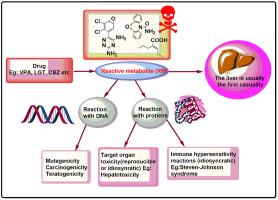European Journal of Medicinal Chemistry ( IF 6.0 ) Pub Date : 2021-10-02 , DOI: 10.1016/j.ejmech.2021.113890 Rohit Pal 1 , Karanvir Singh 1 , Shah Alam Khan 2 , Pooja Chawla 1 , Bhupinder Kumar 1 , Md Jawaid Akhtar 3

|
Several generations of antiepileptic drugs (AEDs) are available in the market for the treatment of seizures, but these are amalgamated with acute to chronic side effects. The most common side effects of AEDs are dose-related, but some are idiosyncratic adverse drug reactions (ADRs) that transpire due to the formation of reactive metabolite (RM) after the bioactivation process. Because of the adverse reactions patients usually discontinue the medication in between the treatment. The AEDs such as valproic acid, lamotrigine, phenytoin etc., can be categorized under such types because they form the RM which may prevail with life-threatening adverse effects or immune-mediated reactions. Hepatotoxicity, teratogenicity, cutaneous hypersensitivity, dizziness, addiction, serum sickness reaction, renal calculi, metabolic acidosis are associated with the metabolites of drugs such as arene oxide, N-desmethyldiazepam, 2-(1-hydroxyethyl)-2-methylsuccinimide, 2-(sulphamoy1acetyl)-phenol, E−2-en-VPA and 4-en-VPA and carbamazepine-10,11-epoxide, etc. The major toxicities are associated with the moieties that are either capable of forming RM or the functional groups may itself be too reactive prior to the metabolism. These functional groups or fragment structures are typically known as structural alerts or toxicophores. Therefore, minimizing the bioactivation potential of lead structures in the early phases of drug discovery by a modification to low-risk drug molecules is a priority for the pharmaceutical companies. Additionally, excellent potency and pharmacokinetic (PK) behaviour help in ensuring that appropriate (low dose) candidate drugs progress into the development phase. The current review discusses about RMs in the anticonvulsant drugs along with their mechanism vis-a-vis research efforts that have been taken to minimize the toxic effects of AEDs therapy.
中文翻译:

抗惊厥药物的反应性代谢物和减少药物不良反应的方法
市场上有几代抗癫痫药物 (AED) 可用于治疗癫痫发作,但这些药物与急性至慢性副作用相结合。AED 最常见的副作用与剂量有关,但有些是由于在生物活化过程后形成反应性代谢物 (RM) 而发生的异质性药物不良反应 (ADR)。由于不良反应,患者通常在治疗之间停药。丙戊酸、拉莫三嗪、苯妥英等 AED 可归入此类类型,因为它们形成的 RM 可能会出现危及生命的不良反应或免疫介导反应。肝毒性、致畸、皮肤过敏、头晕、成瘾、血清病反应、肾结石、ñ-去甲基地西泮、2-(1-羟乙基)-2-甲基琥珀酰亚胺、2-(磺胺乙酰基)-苯酚、E-2-en-VPA和4-en-VPA和carbamazepine-10,11-epoxide等。 主要毒性与能够形成RM的部分相关联,或者官能团本身在代谢之前可能过于反应。这些官能团或片段结构通常被称为结构警报或毒物。因此,通过对低风险药物分子进行修饰,最大限度地降低药物发现早期先导结构的生物活化潜力是制药公司的首要任务。此外,出色的效力和药代动力学 (PK) 行为有助于确保适当的(低剂量)候选药物进入开发阶段。相对于为尽量减少AEDs治疗的毒性作用而进行的研究工作。











































 京公网安备 11010802027423号
京公网安备 11010802027423号